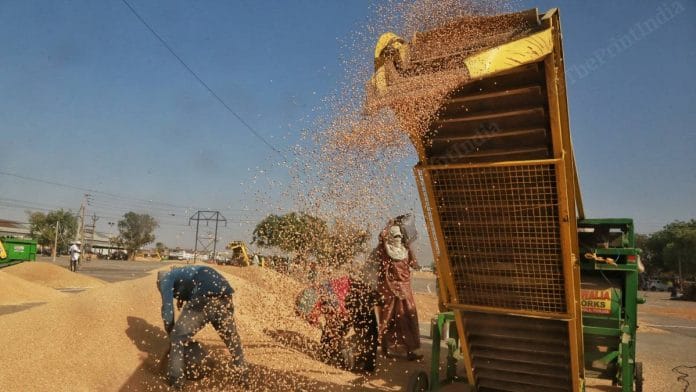New Delhi: At a time when wheat farmers across the country are reeling from poor harvests due a scorching March, scientists at the Indian Council of Agricultural Research (ICAR) have released a new heat-resistant variety of the crop.
Known as HI 1634 or ‘Pusa Ahilya’, this variety is described as suitable for the climate of a belt running from Rajasthan and Gujarat in the west, through Madhya Pradesh, to parts of Uttar Pradesh. It is said to allow farmers to protect their crops from heatwaves even if they sow their crops later than usual.
After three years of field trials, the variety is available for cultivation in the next season in the aforementioned states.
The Pusa Ahilya variety can be sown as late as December or January, according to the researchers who developed it. Flowering occurs within 100 days, which means that the crop can be harvested in March. Wheat is usually sown in October-November and harvested in March-April.
“HI 1634 or Pusa Ahilya was released for late sowing conditions — that is, for those farmers who want to sow wheat after potatoes or any other crop in the month of December or January,” Divya Ambati, a researcher at ICAR-Indian Institute Of Oilseeds Research in Madhya Pradesh, and part of the team that developed the variety, told ThePrint.
“This is a bread wheat variety, and useful for preparation of chapatis, biscuits, and bread,” she added.
This year, the heatwave in March caused yields of several crops, including wheat, to slump across the country. Confronted with lower wheat production and rising prices, the government banned wheat exports last month.
With food security in the wake of climate change becoming a global cause of concern, climate-resistant varieties of crop have become increasingly important.
According to S.V. Sai Prasad, principal scientist at ICAR-Indian Institute of Rice Research, who led its development, Pusa Ahilya is not only “heat-resistant”, it has a yield potential of 70.6 quintals per hectare.
For context, the average wheat yield in Punjab, a major producer, was reportedly around 42 quintals per hectare in 2022 and approximately 48 quintals per hectare the year before that.
Also Read: From tomatoes to wheat, Indian crop forecasting is in the grip of a Raja Todar Mal problem
Wheat feels the heat
The production as well as quality of wheat can suffer when temperatures rise above optimal levels.
Wheat is particularly vulnerable to heat stress during the “anthesis” stage — when the crop flowers.
During this critical stage, if the crop is exposed to heat over the average of 23 degrees Celsius, the grain starts maturing faster, and ‘fills up’ less. This results in a lower yield.
This year, many parts of India experienced an early and prolonged heatwave, with temperatures reaching record highs in March and April.
The early onset of summer hit wheat production hard. Due to the heatwave in March, wheat production is estimated to be 10 per cent lower in 2022 compared to the year before. Last month, the government had to lower its estimates for wheat production by 5.7 per cent to 105 million tonnes in the 2021-22 crop year ending June, from the earlier projection of 111.32 million tonnes.
Pusa Bakula: Nutritionally enhanced wheat
In addition to Pusa Ahilya, the ICAR team has also developed another variety of biofortified or nutritionally enhanced wheat that it describes as rich in zinc and also suitable for making chapatis, biscuits, and bread.
Known as HI 1636, or ‘Pusa Bakula’, this variety was released this season and is suitable for sowing in November and has a yield potential of 72 quintal per hectare.
“[Pusa Bakula] is a variety that has been released after 16 years of the previous variety that was released for the same conditions,” Ambati said. “Over the years, the stability of the properties we expect in a variety keeps reducing.”
After three to four years of cultivation, the genes of the varieties may develop variants that compromise their properties. “It is not possible to track every gene mutation. So, every few years, some new characteristic may crop up,” Ambati added. “To continue to improve the yield, we keep working on developing new varieties.”
In 2008, ICAR released a biofortified crop called HI 1544 for early winter sowing in central parts of India. Its yield potential was around 55 quintals per hectare.
(Edited by Asavari Singh)
Also Read: Inertia or economics? Why Punjab’s farmers can’t move beyond rice and wheat






